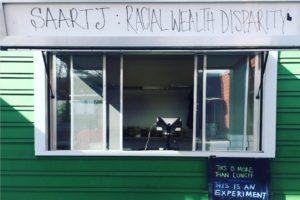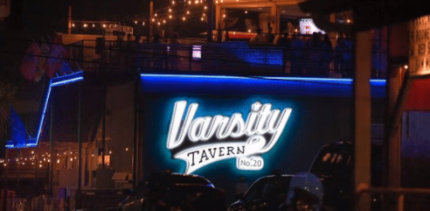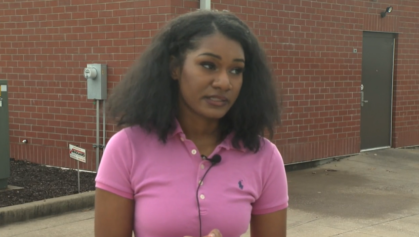
Social experiment by Chef Tunde Wey. Photo: Eater.com
In society, privilege is everywhere in terms of wealth and race. Yet those who are the beneficiaries of privilege may not necessarily be compelled to come to terms with its impact on them and how they travel through the world living premium lives. One Black restauranteur in New Orleans has challenged white people to consider the personal benefits of their white privilege and to surrender that privilege, if only temporarily.
Through March 4, Chef Tunde Wey has set up what is best described as part lunch spot, part social experiment in the Roux Carre food court market in New Orleans. Wey’s Nigerian food stand is called Saartj, which is named after Saartjie Baartman, the South African woman known as “Hottentot Venus” who was exhibited throughout early nineteenth century Europe for her large buttocks. Customers of color — Black, Latino and Asian — at Saartj pay a standard rate $12 for a meal. However, white patrons have the option of paying $12, but Wey also tells them they can pay $30 — reflecting the racial wealth gap in the city — with the profits redistributed to nonwhite customers.
Customers were asked to fill out an online survey, an exit interview that a Tulane Student prepared, to shed light on why people selected a particular price level. Diners were also asked questions about the how their wealth or lack of wealth influenced their life trajectory. Contrary to expectations that only a few whites would pay the price of their privilege, 80 percent of white customers paid the $30, deciding to give up their privilege when confronted with social pressure. Even those whites who paid $12 apologized and tried to justify their decision. A few white participants canceled their order and walked away entirely. The results revealed that people of color were far more aware of the racial wealth gap, how it impacted their lives, and the ways in which their lack of access to resources disadvantaged them with respect to white people. Some Black people attempted to pay $30, though only $12 was accepted from them. Generally, people of color tend to have less wealth, and the exercise was an opportunity to look at wealth not only as a matter of an individual’s income, but rather family and community security — or lack thereof — circumstances that determine opportunities, jobs, access to health care and other matters, and perpetuate systematic institutional racism.
Various studies illuminate the problem of racial wealth inequality in New Orleans and on a national level. According to a 2016 report by Prosperity Now (pdf), the median income for Black households is $25,806, but $64,377 for white households, with six times as many African-American households living in poverty than their white counterparts. Black workers are three times more likely to be unemployed than white workers (15.3 percent vs. 5.1 percent), and 71 percent of African-American households are liquid asset poor, lacking the savings to live above the poverty line for three months in the event of a medical crisis, unemployment or some other disruption to income. Also, 33 percent of Blacks and 43 percent of Latinos own their homes in New Orleans, as opposed to 54 percent of whites and Asians, and the average Black- and Asian-owned home is worth $150,000 — half the value of an average white-owned home.
As NPR reported, white households accumulate wealth more quickly, with the Federal Reserve’s Survey of Consumer Finances finding in 2013 that the median white family had 13 times more net wealth than the median Black family, and 10 times the wealth of the median Latino family. These disparities are a reflection of slavery, segregation, redlining, years of exclusion of nonwhites from the GI Bill, and other forms of institutional racism that have kept people of color on the outside and have allowed white people to accumulate wealth and pass it down to successive generations.
This social experiment in dining with white privilege in New Orleans is a reminder of Jane Elliott’s famed “Blue Eyes/Brown Eyes” exercise on the effects of racial prejudice and discrimination. Following the assassination of Martin Luther King, the teacher, a future lecturer and diversity trainer, devised the experiment, which labels people as superior or inferior based on their eye color and allows them the opportunity to experience life as a member of an oppressed minority group. On April 5, 1968 in her third-grade class in Riceville, Iowa, Elliott separated the blue-eyed children from those children with brown or green eyes. She asked the blue-eyed students to each wear a green construction paper armband. “The browneyed people are the better people in this room,” Elliott told them. “They are cleaner and they are smarter.”
“Eye color, hair color and skin color are caused by a chemical,” Elliott continued, referring to melanin and writing the word on the board, telling the children the substance makes people more intelligent. “Brown-eyed people have more of that chemical in their eyes, so brown-eyed people are better than those with blue eyes,” she said. “Blue-eyed people sit around and do nothing. You give them something nice and they just wreck it.”
Elliot found that the exercise began to transform her class, as withdrawn and slower children with brown eyes became confident leaders. Blue-eyed children who never had problems with math began making multiplication mistakes, and brown-eyed children ganged up on those with blue eyes and proclaimed their superiority. That was a Friday. On the following Monday, Elliot put things in reverse and made the brown-eyed kids the dumb, lazy and inferior ones. After the experiment, some of the children hugged and cried, and Elliott learned that the blue-eyed students were not as cruel as their brown-eyed classmates, presumably because the blue eyes had experienced the sting of discrimination — as if they walked in a Black child’s shoes for a day.
Eliott’s exercise in eye color, like Saartj in New Orleans, demonstrates the power of social pressure and the impact of systemic racism and points to solutions to ending inequality. While a social experiment may make cause its subjects to feel uncomfortable, inferior, or unduly superior for a brief spell, institutional forms of oppression bring permanent discomfort, pain and diminished life opportunities to Black people, and accumulated and inherited wealth with compounded interest to white people, in perpetuity. White privilege has a price tag that the privileged rarely are forced to consider outside of social experiments.


